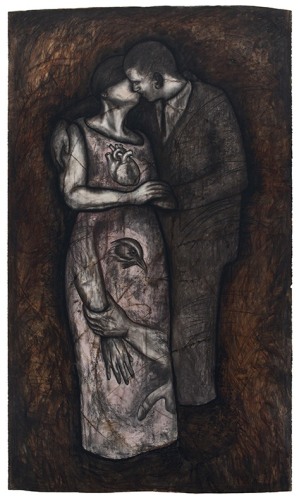
Our Kiss, 1990
Oil stick and charcoal on paper
84 1/2 x 50 inches


Opening Reception: Thursday May 4, 6-8pm
[Lovell] works in a shadowy periphery between substance and ephemera, two and three dimensions, spiritual and material culture, self and other, populating this ambiguous space with people, places, and objects from the past.
– Lucy Lippard
DC Moore Gallery is pleased to present the exhibition, Whitfield Lovell: What’s Past is Prologue, comprised of over thirty large- and medium-scale works on paper created between 1987 and 1998. This is the first time in several decades that such an extensive collection from the artist’s earliest body of work is on view.
During this early period Lovell worked on large sheets of paper that he layered with oil stick and charcoal. He chose to work in deep, vibrant monochrome that gives the works a dramatic gestural presence, combined with finely executed charcoal drawings that are the forebears of the artist’s ongoing practice. His subjects are often sourced from vintage photographs from family albums as well as anonymous photos.
Lovell speaks allegorically through his visual symbols, examining issues of identity, gender, love, death, and loss. Hands contain faces and figures, some mysterious, others easily identifiable. Empty clothes express the presence of absence – spiritual, emotional, or physical – of friends and family members. Lovers kiss. And a head rests on its side atop a mound of flowers, in a reference to both a Mexican burial tradition and a deeply felt family tragedy.
Much of the work is personal, even autobiographical, grounded in the artist’s past. Blending narrative and metaphor, Lovell’s work creates meanings that are, as in everything he has done since then, shaded with ambiguity that invites multiple interpretations. And as personal as much of the imagery is, he intended the works to be broadly understood. As he explained in the early 1990s,
“I think it is important for the viewer to bring some of his or her own associations to the work. … I want it to be open enough so that people can interpret and relate the images to their own experiences.”
In 27 Hands (1990), a group of open palms, each depicting a single symbol or a motif, including a peace sign, skull and bones, swastika, Turkish crescent and star, dollar sign, Star of David, and male and female gender signs, is set against an atmospheric background of blood reds and rich dark browns. This confluence of color and graphic iconography is emblematic of the artist’s concerns throughout this entire body of work. These themes are further echoed in another composition entitled Tree (1989), in which sinewy branches bear ghostly faces evoking genealogical history instead of fruit or blossoms, in a metaphor for remembrance and foretelling.
A recipient of the John D. and Catherine T. MacArthur Foundation Fellowship Award in 2007, Whitfield Lovell has been the subject of numerous exhibitions, most recently Whitfield Lovell: Kin Series & Related Works at the Phillips Collection in Washington, DC in 2016-17. The presentation was accompanied by a major monograph, Whitfield Lovell: Kin, published by Rizzoli. Lovell’s Pop/Pistol (1990) was featured in the 2017 exhibition Inbox at the Museum of Modern Art, New York. His 54-piece installation Card Series II: The Rounds (2006-11) is currently on view at the National Museum of African American History and Culture, Washington, DC. Works from the early years spanned by this exhibition are in the permanent collections of many museums, including the Metropolitan Museum, Museum of Modern Art, National Gallery of Art, and New Orleans Museum of Art. He is also represented in the collections of the Whitney Museum of American Art, Brooklyn Museum, and Studio Museum in Harlem in New York; High Museum of Art, Atlanta; Smithsonian National Museum of African American Art, Washington, DC; Yale University Art Gallery, New Haven; Baltimore Museum of Art, Maryland; Los Angeles County Museum of Art, California; Bronx Museum of Art, New York; Chrysler Museum of Art, Virginia; Columbus Museum of Art, Ohio; Seattle Art Museum, Washington; Smith College Museum of Art, Massachusetts; Morris Museum of Art, New Jersey; The Phillips Collection; Washington, DC; Neuberger Museum of Art, New York; Pennsylvania Academy of Fine Arts, Pennsylvania, and Williams College Museum of Art, Massachusetts.